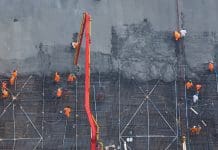When looking to upgrade the thermal properties of buildings, careful thought needs to be given to the risks associated with this – in particular when there is a requirement to insulate at rafter level.
Probably the most significant risk is that of creating interstitial condensation which can lead to mould and ultimately damage the building fabric through decay. Here Mark Seddon of Thermic Technology talks about this and other considerations and how a new generation of insulating breather membranes is helping to deliver a better, less intrusive thermal solution.
Of the estimated 23 million households in England around half the properties (53%)1 are reportedly terraced or semi-detached houses. History will tell us that many of these properties were built either between the two wars of the last century or after the 2nd World War. Whichever category they fall into, these homes have been the focus of Government targets for increasing their energy efficiency since 1996 as they have less insulation than homes built today.
Although energy efficiency is improving according to DECC (Department of Energy and Climate Change)2 around 35% of all homes in the UK still require loft insulation. Yet when it comes to insulating a loft a major consideration will be where to position the insulation.
One of the most important factors in deciding the positioning at rafter level will be the acceptability of a raised roof line as the addition of insulating sarking boards and counter battens will require the roof to be raised.
This brings visual and technical problems which are not just limited to historic and listed buildings but more everyday properties such as terraced and semi-detached properties. Here raising the roofline of such neighbouring properties is unacceptable.
PhotonAir, launched earlier this year manages just this issue to the point that it actually isn’t an issue. The LABC registered product is fully breathable, air-open and crucially, does not need to be counter battened – it can simply be draped over the rafters just as for a conventional breather membrane. This avoids the need to raise the roof – an ideal choice for difficult to insulate buildings.
The reflective insulating breather membrane works by combining the thermal performance of multifoil insulation with Klober Permo® air underlay. It has been designed for use on the cold side of the building in roofs and walls. The product upgrades insulation and manages condensation whilst retaining the roofline and opens up the insulation possibilities for terraced and semi-detached properties alike.
Points to consider when upgrading insulation at rafter level
- Rafter depth may limit the insulation that can be installed between them and it may not be practical or possible to put additional insulation on the underside.
- Where rafters are shallow (less than 75mm) a limited depth of insulation can be accommodated.
If a lath and plaster ceiling also exists then forcing it into the rafter space may damage the ceiling below.
- As lath and plaster ceilings are very moisture permeable the risk of condensation from
using non-breathable insulation is increased. Installing a vapour barrier isn’t usually an
- option. An alternative is to install an insulating breather membrane instead of a conventional breather membrane if you have 50mm or more of rafter space above the ceiling.
- • Where a property has exposed purlins and rafters, installing a vapour barrier won’t be practical, so using a build-up that won’t pose a condensation risk is vital. In these circumstances an insulating breather membrane is ideal.
- • A high standard of workmanship is needed to achieve effective insulation with rigid insulation as careful jointing and sealing of the gaps is essential; flexible insulating breather membranes are easier to install.
- • Insulating breather membranes are popular in social housing as they can improve the thermal performance of a group of adjoining properties without raising the roof height or disturbing the occupants and the interior finish of the property.
- • Where 50% of the roof is being refurbished then insulation also needs to be upgraded an as insulating breather membranes are quick and easy to install they can leave a roof watertight in a day.
- • Where the standard is not technically, functionally or economically feasible, then the thermal element should be upgraded to the best standards achievable – delivering a simple payback of no greater than 15 years. Generally this lesser standard should not be worse than 0.7w/m2.k –insulating breather membranes can achieve a U-value of 0.60 in 75mm rafter at 400mm spacing.
- • Air-open are the most breathable insulating breather membranes (air-open membranes allow more water vapour to pass than air-closed). NHBC accepts the use of membranes certified as both air and vapour-open without the requirement for supporting ridge or high level ventilation.
Thermic Technology is a British-based company which specialises in the design and manufacture of thin reflective insulation for the professional and self-build markets. Its people have been at the forefront of the multifoil insulation industry since 2006 and understand how to create cost effective, thermally enhanced insulation products. If you would like more information about PhotonAir for the range of insulation solutions from Thermic Technology visit www.thermictechnology.co.uk .
1 English Housing Survey 2013-14
2 The Guardian, 26th September 2012
Thermic Technology Ltd
Moorland Gate Business Park
Chorley
Lancashire PR6 9FE
Tel: 01257 241084
info@thermictechnology.co.uk













